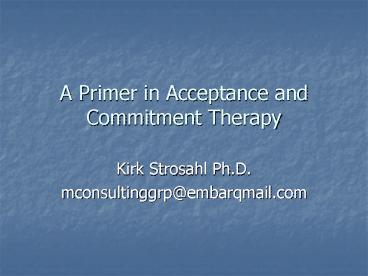A Primer in Acceptance and Commitment Therapy - PowerPoint PPT Presentation
1 / 17
Title:
A Primer in Acceptance and Commitment Therapy
Description:
... upon personal values, identify a compass heading that will make purposeful and ... The sense of vitality, purpose of meaning in the present moment is always ... – PowerPoint PPT presentation
Number of Views:343
Avg rating:3.0/5.0
Title: A Primer in Acceptance and Commitment Therapy
1
A Primer in Acceptance and Commitment Therapy
- Kirk Strosahl Ph.D.
- mconsultinggrp_at_embarqmail.com
2
Acceptance and Commitment Therapy Overview
- Human pain (physical and psychological) is
ubiquitous, normal and self restorative - Unwillingness to have pain leads to reliance on
avoidance and control based strategies - This lack of willingness leads to a loss of
contact with committed actions vital purposeful
living - It is not physical/mental pain per se that is the
enemy but our attempts to avoid or control it
(i.e., suffering)
3
ACT Model of Suffering FEAR
- Fusion Attaching to unwanted private experiences
through literality - Evaluation Imbuing experiences with primary
evaluative properties that become fused with the
experience - Avoidance Using behavioral or psychological
strategies designed to eliminate or contact
exposure - Reason Giving Providing a socially supportable
justification for dysfunctional and unworkable
behaviors
4
The ACT Alternative
- Accept Get present, without struggle or
evaluation, with what is there for what it is,
not what it advertises itself to be - Choose Based upon personal values, identify a
compass heading that will make purposeful and
legitimate what is to be gone through - Take Action Act in ways that are consistent with
values, regardless of the magnitude of these
actions, understanding that one does not obtain
values
5
Core ACT Processes
- Defusion Deliteralizing provocative events
- Acceptance Non-judgmental awareness
- Getting in the present moment Showing up
- Self as context Contacting the transcendental
sense of self in which all experience is safe - Valuing Standing for something in core areas of
existence - Committed action Engaging in behaviors that are
consistent with personal values
6
When Is Acceptance An Alternative To Change?
- Remember the serenity prayer?
- With natural, conditioned uncontrollable private
experiences such as emotions, memories, thoughts,
sensations - When a situation cannot be changed
- Presence of chronic disease, pain, terminal state
- The attitudes, beliefs and behaviors of others
- When change or control strategies produce
paradoxical results (i.e., try not to think about
X)
7
What Can Be Controlled and Changed?
- Most are within the patient
- Behavioral responses
- Willingness to get present
- Clarification of values and associated strategies
8
Forms of Acceptance
- Resignation or defeat
- Toleration
- Willingness to be present with struggle
- Non-judgmental awareness
- Sublime acceptance
9
Clinical Impacts of Acceptance
- It tacitly normalizes events that might be
viewed as abnormal - It highlights the distinction between the human
and the event - It highlights learning to live with undesirable
but unchangeable circumstances - It provides a place from which valued actions can
be undertaken in the face of adversity - It orients the provider to the limitations of the
eliminate and cure agenda
10
How to Introduce Acceptance as the Alternative
- Highlight the unpredictable, uncontrollable
nature of the problem - Empathize with the patients normal, socially
supported desire to control/eliminate the problem
(what have you tried?) - Help the patient connect with direct experience
of failing to succeed at this agenda (how has it
worked?) - Connect the patient with the paradoxical effects
of the eliminate/control agenda (what has it cost
you?)
11
How to Introduce Acceptance as the Alternative
- Get the patient in contact with the most
important cost Cessation of value driven,
committed actions that promote quality of life - Suggest willingness as an alternative to
control/elimination - Be comfortable promoting tidbits of willingness
- Emphasize that willingness is not a trick to
change the situation - Emphasize acceptance is not a static mental state
but a continuing process of committed action
(choice) - Dont guarantee any outcome!! What will happen
will happen
12
Values and Committed Action
- Values are the diamond in the rough that we
want to activate - Work/career/community usefulness
- Love/intimate relationships
- Family/parenting
- Friends/social connectedness
- Personal growth
- Health and hygiene
- Spirituality
13
What Freud Said!
- The foundation of freedom from neurosis is the
successful pursuit of three main objectives in
living - Work
- Love
- Play
14
Unusual characteristics of values
- Not based upon reasons, but rather represent
starting assumptions (I stand for X) and cannot
be argued - Cannot be obtained in any single event (there is
always more west to go) - A source of tremendous intrinsic motivation
- Often suppressed in our acculturation and in the
process of victimization - A very clean hands place to go clinically
- Pulls the best of us
15
Committed Actions
- Actions which are consistent with ones self
identified values - These actions are choices that will be made in
the presence of reasons, but not for reasons - Not choosing is a form of choice, often
succumbing to reasons - Committed action is not based on the magnitude of
the act - The sense of vitality, purpose of meaning in the
present moment is always greatest when actions
are consistent with values - Committed actions can also produce clean pain
16
Basic ACT Question
- Would you be willing to experience, fully and
without defense, what is there to be experienced,
and, at the same time, do what needs to be done
to promote a sense of vital purposeful living?
17
Suggested Readings
- Hayes, S. Strosahl, K. (2005). A practical
guide to acceptance and commitment therapy. New
York Springer Publishing. - Hayes, S., Strosahl, K. Wilson, K. (1999).
Acceptance and Commitment Therapy An
experiential approach to behavior change. New
York Guilford Press.

